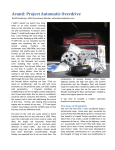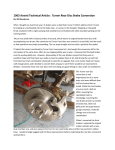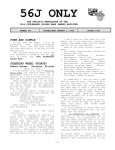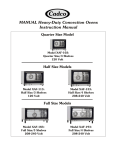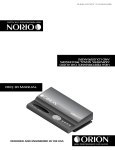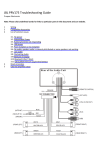Download avanti wiring harness article.indd - Bob`s Studebaker
Transcript
Avanti Repair Main Wiring Harness Replacement By: Bill Henderson, AOAI member, [email protected] It is not a topic you will find covered anywhere in the lengthy and detailed Avanti service manual. An Internet search on this subject turns up nearly nothing, and looking at the title of this article, your passing thought might be, “how hard could this be? You simply unplug all the old wires and plug the new ones in!” Except in reality it is not quite that easy. The real challenge comes from the tight confines in which one must work to make the replacement; the fact that all old wiring must be removed before the new wiring will fit; that testing and troubleshooting needs to be done in close quarters; and the fact that there are some modifications that you will probably need to make along the way to have everything work like you hoped when all finished. This under hood rats’ nest shows much evidence of splices and patches gained over the years. Everything worked, at least most of the time. But just looking at this mess made me shudder. The common school of thought is to leave things like this alone unless they are really broken. But I’ve replaced the wiring harnesses on each of the three antique cars I have restored. It’s not a glamorous job, and when complete it is nearly invisible and thoroughly unexciting in function. No car owner says, “Oh, come, you must see how safe and reliable my lights, horn and heater are!” People simply expect things to work when the knobs are turned, and it is much, much more fun to spend money on things like chrome wheels, electronic gadgets or fancy paint. But the real reason that this topic is not even mentioned in the shop manual is that no one anticipated that we would still be driving our cars a half-century after they were built. The main wiring harness was not something that was ever intended to wear out in the lifetime of the car, and surely no one ever planned for these cars to be driven fifty or more years after they were made. But besides the simple passage of time, the environment in which these wires and connection live 2 AVANTI Magazine are very harsh… freezing cold, broiling heat, bathed in dirty water, oils, solvents, acids: these all corrode connections and cause cracks in once-pliable insulation. Copper wires are bared and once-tight connections become corroded and loose. Bad connections add resistance to circuits and generate heat; brittle and cracked insulation on wires and connections is a short circuit and a fire waiting to happen, and a fire in a fiberglass car is not a pretty scene to imagine. The first signs of problems may be dim or flickering lights, accessories that work sometimes and not the next, instruments that can’t be seen at night, turn signals that blink too slowly or not at all. These are all dangerous and annoying. Sadly, I have experienced first-hand a serious electrical “incident” in another one of my collector cars, when an un-fused circuit (yes, there are several of these in every car, including the Avanti) connection came loose under the carpet; the cracked wire insulation allowed the copper inside to short to the floorpan, and within a minute while I waited at a stoplight, the entire wiring harness quickly melted into a sticky, smoldering burning mass. As the harness burned, every accessory bypassed its switch and became energized: the lights, horn, wipers, starter cranking while the engine ran; heater and radio all blaring away, as bitter, choking smoke from the burning carpeting and wire insulation billowed out from under the dash and into my face as I stared with frozen panic at what was happing at my feet. I shut the ignition key off but since it was short circuited, the switch was useless and the engine continued to run! The only thing that saved a total catastrophe was my luck of having a pair of large wire cutters in the trunk, which with quick thinking I used to snip the battery cable to cut the power to stop the inferno from worsening. Had my wife been driving the car at the time she would have had no idea what to do, and the car would have burned to the ground, hopefully only after she had gotten out of it! Under the dash, my Avanti’s wiring looked serviceable—at least in most places, but under the hood it displayed many splices and disintegrating insulation on connectors. Remembering my brush with disaster, I decided to replace the harness before lightning struck me again. I admit I briefly considered splicing the new harness to the old one, replacing only the under hood wiring so I would not have to work under the dash, but decided that this was not a smart shortcut, and decided to do it “right”. Rewiring a car is one of the few jobs in car repair that you’d almost never pay a shop to do, unless it was being done as a part of a complete restoration. While it is not technically difficult and requires few specialized tools, it involves so much tedious labor you need to realize in advance that it will take hours and hours to complete. Sure, if the entire dash was exposed on a workbench, and one could replace the connections serially one at a time, the job would consume two hours at most. But with the dash in the car and working on your back, I promise you the work can easily consume three or four solid days. Fall/Winter 2011 Issue 156 Avanti Repair Let’s get started! Let’s start with the basics. You will need a specialized Avanti harness. In a fiberglass bodied car, all hot leads must have accompanying ground wires. These many extra grounds are not needed with wiring for metal cars, so don’t even consider using the less expensive harness from a Lark and expect it to work! I ordered my harness from Studebakers West, and they told me it would take three months to make, though it arrived in just six weeks. At $445 (in 2010) it was not inexpensive, but it is made to close specifications with all the proper connectors, lead lengths, and correct wire colors. As much as I like to do-it-yourself, if available, buying a pre-made harness for one’s car is money well spent. The Avanti’s main harness as it arrived from Studebakers West. A couple specialty connectors and grommets are not included and must be reuesed from the old. All the many white wires are grounds ,needed since this is a fibreglass bodied car. The Studebaker Avanti has a single main harness that starts at the front of the car at the headlights and horns, travels all the way through the engine compartment past the voltage regulator and starter solenoid, and through the firewall, connecting all the instruments, lights and the devices in the dash and in the console. There is no “quick disconnect” plug at the firewall like you would expect to find on a later model car. Be aware that the standard Avanti replacement main harness from Studebakers West does not include the following: • • • • • Wiring for anything located in the car behind the console: so, excluded are wiring to the rear courtesy lights, gas tank sender, tail lights and backup lights. The set of wires that travels up and inside the left windshield pillar to feed the overhead console switches for the lights and heater. The turn signal wiring harness that feeds inside the steering column. The optional power windows, which have their own separate harness. The floor-mounted window washer pedal and pump wiring, if your car has this option. Tip: Buy a color wiring diagram. True, there is a black and white Fall/Winter 2011 Issue 156 wiring diagram for the Avanti included in the service manual, and one is also available on line on Bob Johnstone’s wonderful resource site (https://www.studebakerparts.com/studebakerparts/ store/s/html/images/63-4-avanti-wire.jpg) but I strongly suggest buying a color diagram from a vendor like www.classiccarwiring. com. Seeing the colors is far easier than trying to read all the tiny codes and text on the black and white line drawings. Note that these Avanti diagrams all seem to omit the circuits for power windows, the radio and the windshield washer pump. The power window wiring diagram can be found at: www.studebakerparts.com/ studebakerparts/store/s/html/images/avantiwindowwiring.jpg Remove the following “in the way” parts before starting: The battery, front seats; steering column (unbolt the rag joint at steering box and pull the column out through inside of car); unbolt the master cylinder and brake power booster as a single unit from the firewall; remove the entire brake/clutch pedal assembly from under the dash, unbolt the parking brake handle from the dash and position it out of the way. Now, before you groan in disbelief and skip to the next step hoping you read incorrectly, note that there are surprisingly few bolts that hold all of these items in place, and compared to other-make cars I have worked on, it is much easier to disassemble the Studebaker. You must believe me—the time spent to remove these parts is miniscule compared to the time you will waste trying to work around them or the damage you may cause to your upholstery, your knuckles (and your back!) if you try to replace the harness with them in place. Carefully document your disassembly: A small digital camera is your best friend. You can stick it up behind the dash and take photos of where every wire is connected before you begin pulling things apart. You will be surprised and delighted to find how valuable one of these photos will be to answer future questions like: “which lug on the wiper switch does the purple wire attach to?” Use masking tape and tag old wires as you remove them to be able to go back and use them for reference. The new wires’ tracer colors often don’t look exactly like the old ones, and it will not be intuitive where things connect when you are contemplating a large bundle of fresh wires with unmarked connections! AVANTI Magazine 3 Avanti Repair Helpful Tip: Invest in a garage laptop. I have an old laptop computer, totally obsolete for business use and with a bad battery, but that still works when plugged into the wall. I use in the garage for the sole purpose of viewing the photos I took at disassembly. My garage laptop is a godsend when trying to remember where the yellow wire goes, or how an assembly looked before I took it apart to paint it. Laptops like this are a dime a dozen on eBay or sites like Craig’s List. When you have everything disconnected, you will find that the old harness comes out more easily by threading the wires from the engine compartment through the firewall and into the car’s interior. If you prefer, you can cut the harness at the bulkhead for easier removal, but be very careful not to cut the power window wiring – or any other later-owner added wires that will not be included in the new harness. Also, I recommend against this because having the old harness in one piece is helpful as a point of reference if you are trying to trace wires in the new one. Before you start installing the new harness, lay the old and new harnesses beside each other on the floor to compare them. You will notice that your new harness may be missing several of the special molded connectors, plug interlocks, and molded-on grommets that are a part of the old one. The special white plastic shielding connectors at the windshield wiper switch, the shifter “start in park” interlock wire and backup light connector can be carefully removed from the old harness and be slipped onto the new wires. The old ashtray light bulb socket must also be reused. The rubber grommets that are molded to the old harness where it passes through holes in the console are not included on my new harness, and I carefully sliced them off the old harness and taped them on the new. If you look closely, you may also see wires that have been spliced or modified in the original harness over the years, used to power a modern audio component or for auxiliary gauges that you are still using. It is best to neatly modify and surgically add these connections to the new harness here on the workbench before everything is stuffed back up under the dash. In my car’s case, it had its tachometer “guts” replaced with modern electronics hidden discretely behind the old gauge face. I found the wires that fed the old-style sending unit had been clipped and taped off on the old harness, and new connections were substituted. Likewise, auxiliary audio components are installed in my glove box, and spliced connections had been made to attach their power, memory circuits and light bulbs to the rest of the dash wiring. It is easier to make these modifications now, than later while lying on your back under the dash! Above and below, these “before” shots proved to be incredibly helpful when connecting the new wires. The wiper switch above has five lugs, but the new harness needs these connectors to be reused; the main fuse panel below has a confusing number of black wires that all belong to different circuits. The new wiring harness will feed through the firewall hole from either side- though it is marginally easier to fit the wires through the hole from the interior, pushing them through the hole into the engine compartment. Now, here indeed begins a process of replacing each wire where the old one was removed, using your photos, masking tape tags and wiring diagram for reference. The following are valuable tips, learned from doing: • • • 4 AVANTI Magazine Because the Avanti’s body is fiberglass, nearly everything needs to be individually grounded, and that’s why there are so many white wires in the Avanti harness. For example, each gauge needs a ground, as does the windshield wiper switch, and anything with a light bulb. All grounds must be tight and clean, or hard-to-trace erratic behavior is the result, especially when the headlights are on. Check all the fuse values while the little fuse panel is out of the car and on the workbench. Heaven knows what handy-but-incorrectvalue fuses previous owners may have put in these spots without any regard to their rating. Replace all instrument panel light bulbs while you have everything Fall/Winter 2011 Issue 156 Avanti Repair • • • • • apart, don’t be cheap and reuse the old ones. It is just not worth the hassle of going back and changing bulbs in future months after everything is back together. New red bulbs are available from Studebaker International, or do as I did and get a small bottle of special red dye at the hobby store used for making stained glass, and dye your own bulbs. Don’t try to use regular red spray paint, it makes the glass dark and your lights dim. Make a few extras and keep them in a safe place. Changing the instrument panel light bulbs in the tachometer is arguably one of the worst parts of the whole job. To do it properly you should really first remove the ignition switch assembly (easy- hold the bezel in place on the front of the dash with one hand, while reaching behind the dash to push and turn the switch assembly, giving it a 1/8th turn counter-clockwise. It should pop right out) You may then may have to loosen the two nuts on the tach bracket (in the center; the same threaded shafts used as the electrical contacts) and twist the whole tachometer assembly 1/8 turn to get at the top bulb. Replacement harnesses use clip-in, self grounding light bulb sockets for dash and instrument lighting that are often inferior (or at least different) from the ancient originals. More than occasionally, I have unsoldered and reused many of the old light sockets from the original harness because the new ones would not stay tightly in their dashboard or console holes, therefore making bad ground connection and causing annoying flickering until I replaced them with the timeworn originals. Remember, if interior lights flicker or are unreliable while the car is sitting in your garage, I promise they will be unreliable in service, and stop working after the third railroad grade crossing you encounter, well after everything is all put back together. The Avanti’s center floor console lighting is especially Rube Goldberg in its wiring design. Consider adding soldered grounds screwed to a good ground to the two bulbs that illuminate the lettering on the console heater/vent controls. Carefully tighten all electrical connections as you go. There is nothing more frustrating than suspecting loose wires after everything is all buttoned up because something is not working right or fuses keep blowing. As you go along and attach the wires you are looking for, you will come across wires you are not ready to use just yet. If you figure out what each is for, take a second to add a tag with masking tape and marker—this saves so much time in the end! A steel bar runs under the dash from one side of the car to the other. Known as the “Z Bar”, It is used as a grounding point for several electrical connections. Drill a hole in an inconspicuous place and add a dedicated grounding lug to the bar. Run a medium- Fall/Winter 2011 Issue 156 • heavy 8 or 10 gauge wire from the grounding lug, through the firewall, to a place on the frame near the battery, just as a safety backup ground. When you begin to wire the dash gauges, use a heavy plastic ziptie to hold the thick wire bundle tight to the Z-Bar so the weight of the thick harness doesn’t rip apart the small connections you are making. Then, when you are finished making connections, permanently strap the harness neatly and securely to the Z-bar with wire ties in several places. Here is the back of the ignition switch-. Notice the live terminals and their close proximity to the grounded steel z-bar. In last month’s issue we showed you how to insulate this trouble spot using a simple aeresol can lid. How to trace wires: One thing you will notice is the overuse of plain black wires in the Avanti harness. Each carries current, but they are not all on the same circuit so they are not interchangeable. The method of tracing these wires from one end of the harness to the other is a simple trick and requires a multi-tester or an ohm meter, preferably one that beeps when it registers a “hit”. Here’s how you do it. Use a clip on the meter’s black test lead to attach to one end of the mystery wire. With the meter set to “Infinity Ohms” or “Continuity”, use the red lead’s probe to touch the other ends of the suspect wires. When you have found the right one, the meter will register continuity, beeping if it is so configured. Use a strip of tape to mark what both ends of the wire are what they are for (if you know), and move on. • The wiper switch must be grounded for the wipers to work properly, and the factory method of simply using a washer under the knob to press the assembly against the metal dash trim, is sketchy at best. I added an additional soldered ground to the switch that I more securely attached to my new grounding lug that I added to the Z-bar. • If you plan to reuse the door pillar courtesy light switches, take great care in handling them. It very difficult to remove the old wires from the switches without damaging them. Use a pair ofneedle nose pliers and apply firm, consistent pressure to the metal connectors only. Pulling on the brittle bakelite switch bodies will break them for sure. For ease in running the new wires into the door jambs from under the dash, use the old wires to pull the new ones through the holes. • AVANTI Magazine 5 Avanti Repair • To do this, clip the old wires that feed through the cowl side panels and tape the new wires to the newly cut ends, then pull the new wires through the hole as you simultaneously pull out the old switch and wires. While you are under the dash, replace all of the firewall passthrough grommets. These plugs help keep heat, odors and noise out of the cabin, and they are far easier to address now than at any other time. Some of mine were so brittle that they literally shattered when I tried to remove them. • • and consider adding a fused link between the battery and the always hot terminal on the starter solenoid for safety. Cover the back of the ignition switch with a homemade plastic cap (see our last issue for a “how to”.) Some early cars with power windows will only allow the windows to be raised with the key in the “on” position, and not in the “accessory” position. This was changed sometime in mid1963 after it was discovered that owners were burning their ignition points by turning the key to “on” with the car not running for the purpose of raising the windows. If you have such a car, (as I do) consider moving the power source for the windows to the “hot with key” side of the starter solenoid. This will allow the windows to be raised with the key in the accessory position. Done- and time to test • This is boring, but important: before applying power to the new harness, ensure that all loose, stripped wires are either connected to their devices, or taped off to avoid a short circuit. Notice the small , four fuse auxiliary panel installed beside the original, wired directly to the battery. It is wired so that two circuits are switched with the key, two are always hot. The silver surface is Eastwood ‘s Thermo-coustic heat barrier Also, while you have everything apart: • • • • • • • • 6 Add a little auxiliary fuse panel for stereo, your GPS, power antenna, etc. connected to ignition switch white/black tracer (shown at far right in photo) I got mine at the NAPA store. Absolutely use the opportunity to heat insulate the firewall, trans tunnel with Dynamat Extreme or its equivalent Consider adding an theft-protection ignition kill switch hidden under the dash Consider installing a more modern under-dash, pedal activated brake light switch (This article is in an earlier issue in Avanti Magazine or at http://www.studebaker-info.org/tech/Bhend/AvantiBSW. pdf) Swap in a solid state signal flasher Consider a change to a solid state voltage regulator Test your alternator to see if it is putting out enough power: If the original equipment alternator still in your car, consider it suspect. Originally rated at 45 amps, mine was barely producing 18 AMPS and led to a frequent dead battery, that I incorrectly assumed was happening just because the car wasn’t driven enough. A non-stock replacement internally-regulated alternator producing 55 amps served me well; for restoration purists have your old alternator rebuilt. Whatever you do, don’t throw it away! Add a electric cut off switch at the battery’s negative terminal, AVANTI Magazine The knob on the negative battery terminal is a cuttoff switch that completely • • • • Ensure that a bulb is installed in every empty bulb socket! Without bulbs in place, shorts are guaranteed in the empty sockets as the wires and springs in the sockets shift around. You will want to test that everything on the instrument panel works before reinstalling the steering column and pedals. While you could just reconnect the battery and see what happens, I strongly recommend a specific testing procedure that is far more sensible in the likely event that you have connected something improperly. Instead of hooking up the powerful car battery, use your trickle battery charger set to its lowest setting, usually 2 amps. Connect its clip-on leads to the battery positive and negative cables, leaving the battery out of the equation. You can now test each of the circuits for proper operation without frying anything, and have less likelihood of annoyingly blowing the fuses if there should be a momentary short circuit someplace while you work. Start by testing the circuits that are always hot regardless of the Fall/Winter 2011 Issue 156 Avanti Repair • • • position of the ignition key. Make a complete list of these devices and check off each as you have tested it. These include the headlights, taillights, brake lights, horn, courtesy lights, cigarette lighter, instrument panel lights, glove box light, and clock. Next, turn the key to the “on” position and test the circuits that operate only when the car is switched on. These include the radio, wipers, heater fan, power windows, shift lever indicator light, and the fuel gauge. Check every light bulb for illumination. Note that some electric devices that draw a lot of current, like the headlights, horn and power windows may seem nearly dead, work erratically or not work at all when connected to the 2 amp battery charger. Also, sensitive electronics like stereos and amplifiers should not be run on the two-watt feed as it may damage them. For these you will need to verify their proper operation only after the car battery is attached. Use extra caution testing the wipers if you have disconnected the motor from the wiper arms at any point in your project. Paint jobs are easily ruined by wipers that attempt to bury themselves in the cowl with great force when they are attached misaligned. Once you are satisfied that everything is operational, you can now reinstall the pedals and steering column and reconnect the turn signal wires to test the function of the signal and brake lights. If everything is good so far, only now reconnect the battery and try out the power windows, horn and headlights on both high and low beam settings checking for proper operation. Finally, you are nearly ready to try the starter to ensure that it cranks when the key is turned all the way to the “start” position. The operation of the tachometer and the water temperature gauge can only be tested with the engine running. This may seem like a nagging point to add, but before you do try to crank the engine, STOP here and spend the time to secure all wires and hoses away from spinning accessories or hot engine surfaces, and look at every connection for possible short circuit conditions. Nothing will spoil your pride in a project well done than suddenly melted wires that had been lying unnoticed against the exhaust manifold; wires that get caught or wrapped up in the steering mechanism or ripped out unceremoniously by a spinning fan pulley. Likewise, the time to find out that your starter cable is lying against the exhaust manifold is now, and NOT after it has burned halfway through and the sparks start flying through the smoke. Have I been affected by any of these problems? Sadly the answer is yes. In my excited haste to “try things out” in the past I have melted wires and even fried my speedometer cable against an exhaust header pipe because I carelessly removed and forgot to replace a small clip that held these to the steering column mount. And, yes, even on this job, with all my care- when I first started the engine I was confused and mystified to see brake fluid oddly spritzing out of the end of one of the disconnected master cylinder brake lines, and then when I grasped the brake line to redirect it, was very surprised to find it burning hot. The brake fluid was unexplainably actually boiling inside the tube and squirting out the end! Nursing my burned hand, I observed that the brake line was indeed wedged up against the fender-mounted starter solenoid, and the line was in direct contact with the un-insulated solenoid connection end of the thick cable running to the starter. So, every Fall/Winter 2011 Issue 156 time I cranked the starter, I created a short circuit using the brake line as my unintended ground, causing it to get hot enough to instantly boil the brake fluid inside. Heat shrink tubing is your best friend: I went back and repositioned things, but also took the precaution of slipping a thick piece of heat shrink tubing over both the exposed metal ends of that new starter cable to lessen this accident’s likelihood of happening ever again. So...something doesn’t work and you are stumped? Read this before tearing things apart in search of a broken motor or burned solenoid. Remember what I said about grounds... and unless you are highly accustomed to working on fiberglass cars or boats, chances are good that even after my warnings you will take your grounds for granted. Now, many devices need to have their cases grounded to work properly, but after all, in a steel vehicle, anything screwed to the frame or unibody is automatically grounded without you even needing to think about it. Not so in the Avanti. Case in point: the starter solenoid mounted under the hood on the fender apron performs the important task of engaging the starter to the engine when you turn the key in the dash. Without that little solenoid, you’d need a huge high-amp starter switch on the instrument column with battery-cable thick wires connected to it. (That’s why old-old fashioned cars had their starter button on the floor!) The more modern solenoid works by signaling a magnetic switch relay inside its case to jump closed and make the heavy-duty connection between battery and the starter when you turn the key. But for that magnet to work, the solenoid itself must be grounded. Now, in my old Ford, that ground happens simply because the solenoid is screwed to the metal fender. But in the Avanti, an individual white ground wire in the harness is reserved for the solenoid, and that wire must connect solidly to the solenoid’s fender mounting bolt. How long did it take me to realize my problem? Embarrassingly, over an hour, as I swapped out the new solenoid for an the old one, then cursed and puzzled why they both would work with test leads attached on the test bench, but neither would work when in the car. So, I am almost too red-faced to admit to you that I then wasted yet another hour with what turned out to be the same problem when reconnecting the power windows, and finding them stone cold dead. I was sure that I had swapped the relay wires backwards (I hadn’t) and burned it out (I hadn’t). It simply never occurred to me that I needed to make my own grounding connection for the power window relay, as there is no ground terminal provided on this solenoid at all. I must have looked at that wiring diagram easily ten times before I finally saw that ground connection, diagrammed there plain as day, yet invisible to me having spent my whole life up until this point working on steel-bodied cars! ********* Congratulations on doing an important but largely invisible job that will make your car safer and more reliable for the next fifty years. AVANTI Magazine 7 Avanti Repair 8 AVANTI Magazine Fall/Winter 2011 Issue 156








